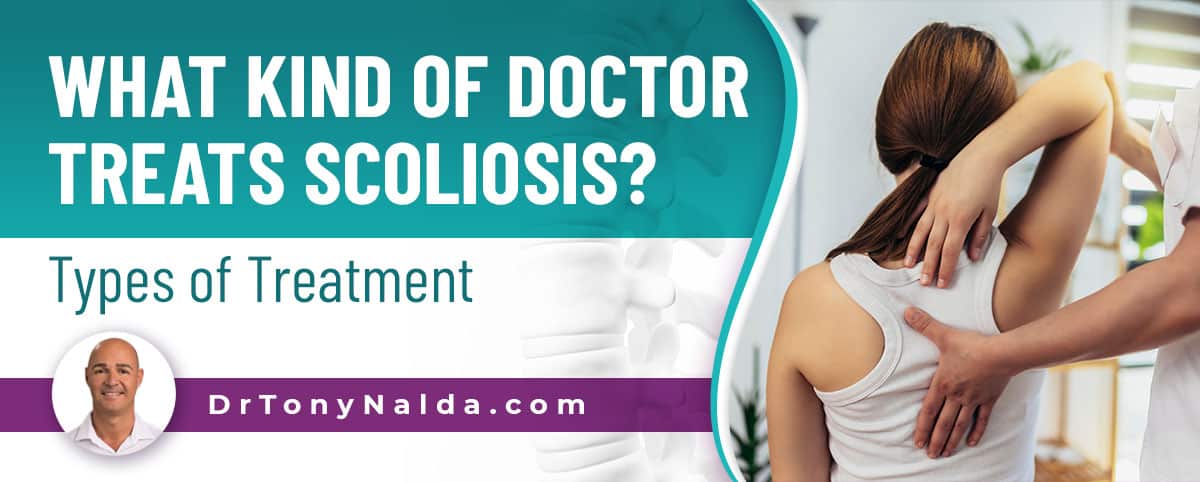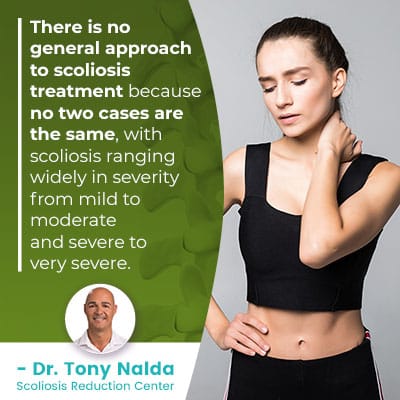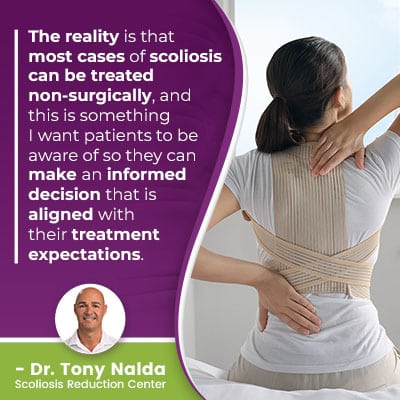What Kind Of Doctor Treats Scoliosis? Types of Treatment

While scoliosis has been around since ancient times, there is still a lot to learn about the condition. When a person receives a diagnosis of scoliosis, the most important decision is how to treat it. There are two main treatment approaches to choose between, and understanding the difference between solely addressing scoliosis symptoms, and treating the condition itself, can have far-reaching effects.
Any general practitioner can treat someone with scoliosis, but only a specialist trained in the condition’s many complexities can effectively treat the scoliosis itself. This is the distinction between treating a condition’s symptoms, or the underlying cause of the symptoms: the condition itself.
The Complexity of Scoliosis
Scoliosis is commonly referred to as a complex condition for multiple reasons.
 There is no general approach to scoliosis treatment because no two cases are the same, with scoliosis ranging widely in severity from mild to moderate and severe to very severe.
There is no general approach to scoliosis treatment because no two cases are the same, with scoliosis ranging widely in severity from mild to moderate and severe to very severe.
In addition to scoliosis being so widely variable in terms of severity, there are also different condition types a person can develop.
The majority of scoliosis cases (approximately 80 percent) are classified as idiopathic, meaning not clearly associated with a single-known cause, and the remaining 20 percent are associated with known causes: neuromuscular, congenital, degenerative, and traumatic scoliosis.
In addition, there are three main sections of the spine, and scoliosis can affect all of them: cervical (neck), thoracic (middle/upper back), and lumbar (lower back).
Scoliosis also doesn’t become a compressive condition until adulthood, so patient age is an important variable in terms of pain and also progression.
As a progressive condition, scoliosis has it in its nature to worsen over time, particularly if left untreated or not treated proactively, which is why the condition is so complex to treat and why it’s so important that it’s treated effectively: to prevent increasing condition severity.
So, in addition to scoliosis ranging from mild to severe, there are multiple condition types with unique causes and treatment needs, and the fact that each case is as unique as the patient themselves necessitates the customization of effective treatment plans.
Being diagnosed with scoliosis means an unnatural sideways spinal curve has developed, with rotation, and it’s the rotational component that makes scoliosis a 3-dimensional condition, as the spine doesn’t just bend unnaturally, but also twists from front to back, back to front: another complexity of the condition.
And what you’re about to learn is that not all treatment approaches address the true 3-dimensional nature of scoliosis: a shortfall that limits treatment efficacy.
So now that we’ve explored the condition characteristics that make it complex to treat, let’s move on to discussing the difference between treating someone with scoliosis versus treating scoliosis itself.
Treating a Patient with Scoliosis versus Treating Scoliosis Itself
As mentioned earlier, there’s an important distinction to be made between treating a patient with scoliosis and treating the scoliosis itself: this is the difference between addressing a condition’s symptoms or treating the underlying cause of the symptoms.
While this distinction might seem obvious, modern medicine often focuses on quick fixes in the form of medication to address pain, rather than addressing the underlying cause of condition-related pain. Oftentimes, this is also what patients want: a quick fix so they can keep up with their daily responsibilities.
Scoliosis treatment provided by a general practitioner (GP) will likely include pain-management options, monitoring for progression with physical exams and X-rays, and recommending some scoliosis-friendly exercises and stretches. However, responding this way to scoliosis doesn’t impact the condition on a structural level, and as a structural condition, scoliosis has to, first and foremost, be impacted structurally.
Not being proactive with treatment can result in a spinal fusion recommendation if/when a patient progresses to the severe level and shows signs of continued progression.
When I say treating scoliosis itself, I don’t just mean addressing a patient’s symptoms, I mean treating the underlying cause of the symptoms, the condition, by working towards a curvature reduction on a structural level.
A specialist who’s trained and certified in a variety of scoliosis-specific treatment disciplines will not only have a more comprehensive understanding of the condition, they are also better equipped at interpreting the results of a scoliosis X-ray, which involves taking multiple comprehensive and precise measurements, to further specify the curvature type and pattern.
I mentioned patients being funneled toward spinal fusion surgery in traditional scoliosis treatment, so let’s start there: spinal fusion.
Traditional Surgical Scoliosis Treatment
Traditional scoliosis treatment often ends in spinal fusion quite simply because it doesn’t have a strategy for treating scoliosis while mild, when at its most responsive to treatment, so applies a watching-and-waiting approach.
The watching and waiting continues until a patient progresses into the severe classification, becoming a surgical candidate; the only form of treatment applied prior to that is traditional bracing, which is associated with a number of shortfalls, mainly related to its failure to treat the condition as 3-dimensional, not addressing its rotational component.
The main issue I see with watching and waiting is that it’s wasting valuable treatment time, and as a progessive condition, where a scoliosis is at the time of diagnosis is not indicative of where it will stay. Only proactive treatment can counteract the condition’s progressive nature.
Seeking treatment from a general practitioner sets patients on the path of traditional treatment.
A general practitioner commonly refers patients to a spinal surgeon for assessment and treatment, and while spinal surgeons know surgery, they aren’t trained in non-surgical treatment options that can be attempted prior to invasive surgery.
Spinal fusion surgery is costly, invasive, lengthy, carries some heavy potential risks and side effects, and when successful, can still cost the spine in terms of its overall strength, health, and function.
If a general practitioner was to refer a patient to a scoliosis chiropractor, the experience, and potential outcome, could be very different.
Conservative Non-Surgical Scoliosis Treatment
 As a CLEAR-certified scoliosis chiropractor, I’m trained and certified in multiple scoliosis-specific treatment modalities, as should any chosen treatment provider be, so don’t be afraid to enquire as to a specialist’s qualifications. After all, there is more than one way to treat scoliosis, and more than one treatment discipline that can be applied.
As a CLEAR-certified scoliosis chiropractor, I’m trained and certified in multiple scoliosis-specific treatment modalities, as should any chosen treatment provider be, so don’t be afraid to enquire as to a specialist’s qualifications. After all, there is more than one way to treat scoliosis, and more than one treatment discipline that can be applied.
Here at the Scoliosis Reduction Center, I treat patients using a conservative chiropractic-centered treatment approach that values proactive treatment started as close to the time of diagnosis as possible.
As such a complex condition, I integrate multiple different forms of treatment into a treatment plan so it can be fully customized to address the specifics of each patient and their condition.
Throughout treatment, I’m monitoring for progression and to see how the spine is responding to treatment so I can adjust treatment disciplines accordingly.
I apply condition-specific chiropractic care to work towards a curvature reduction on a structural level; this is achieved through a series of chiropractic techniques and manual adjustments to reposition the most-tilted vertebrae of the curve back into alignment with the rest of the spine.
A variety of therapies and scoliosis-specific exercises (SSEs) can help increase core strength so the spine is optimally supported by its surrounding muscles, and tight muscles can be stretched, while weak and imbalanced muscles can be strengthened and balanced.
Modern corrective bracing addresses many of the shortfalls associated with traditional bracing and augments corrective results by pushing the spine into a corrective position.
By prescribing a series of scoliosis-specific home exercises, a home-rehabilitation program can be established for long-term sustainable treatment results and to further stabilize the spine.
Following are some of the most respected certifications a medical doctor can receive in scoliosis treatment:
- CLEAR: Chiropractic Leadership, Educational Advancement, and Research focusing on advancing methods of scoliosis rehabilitation, diagnosis, and treatment
- SOSORT: Society on Scoliosis Orthopedic and Rehabilitation Treatment focusing on advancing non-operative management techniques for idiopathic scoliosis
- ISICO: Italian Scientific Spine Institute applying innovation in the rehabilitation of non-surgical spinal diseases
- SEAS: Scientific Exercises Approach to Scoliosis manages scoliosis through physiotherapy scoliosis-specific exercises
- Pettibon System certification focuses on the assessment and rehabilitation of scoliosis and correcting posture
- ScoliBrace certification in corrective 3D bracing
- GOSS: Gomez Orthotic Spine System treats scoliosis with a focus on spinal stability and balance
- Diagnostic training/certification in MRIs, X-rays, etc
Finding a specialist with multiple certifications can have a lot of benefits in terms of treatment efficacy, and the more scoliosis-specific training and experience a doctor has, the more capable they are to draw from each distinct treatment modality to customize the best potential treatment plan for each and every patient.
Conclusion
So what kind of doctor treats scoliosis? The answer is any doctor can treat patients with scoliosis, but only a scoliosis specialist will be trained and experienced enough to impact the condition on multiple levels for true corrective results.
As scoliosis is such a complex and highly-variable spinal condition, it’s beyond the scope of general medicine and requires a condition-specific treatment response.
While traditional treatment favors watching and waiting over being proactive, modern conservative treatment has learned from the shortfalls of this approach by working to prevent increasing condition severity and the need for invasive surgical treatment in the future.
Traditional scoliosis treatment commonly funnels patients towards spinal fusion surgery, while conservative chiropractic-centered treatment focuses on preserving as much natural spinal function as possible by impacting the condition on every level: reducing the curve structurally, increasing core strength for spinal support and addressing muscle pain/imbalance, and establishing a home-rehabilitation program for further stabilizing the spine.
Patients of the Scoliosis Reduction Center have access to numerous forms of treatment and the benefits that each offers under one roof, and you can too, by reaching out here.
Dr. Tony Nalda
DOCTOR OF CHIROPRACTIC
After receiving an undergraduate degree in psychology and his Doctorate of Chiropractic from Life University, Dr. Nalda settled in Celebration, Florida and proceeded to build one of Central Florida’s most successful chiropractic clinics.
His experience with patients suffering from scoliosis, and the confusion and frustration they faced, led him to seek a specialty in scoliosis care. In 2006 he completed his Intensive Care Certification from CLEAR Institute, a leading scoliosis educational and certification center.
About Dr. Tony Nalda
 Ready to explore scoliosis treatment? Contact Us Now
Ready to explore scoliosis treatment? Contact Us Now





